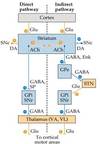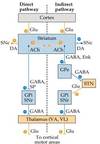Neuroanatomy/Embryology Flashcards

MRA of COW - Axial
•1 - Anterior Cerebral
- 2 – Middle Cerebral
- 3 – Posterior Cerebral
- 4 – Basilar
- 5 – Vertebral
- 6 – Internal Carotid

MRA of COW - Coronal
•1 - Anterior Cerebral
- 2 – Middle Cerebral
- 3 – Posterior Cerebral
- 4 – Basilar
- 5 – Vertebral
- 6 – Internal Carotid

MRA of COW - Sagittal
- 1 - Anterior Cerebral
- 2 – Middle Cerebral
- 3 – Posterior Cerebral
- 4 – Basilar
- 5 – Vertebral
- 6 – Internal Carotid

- A Transverse Sinus
- B Sigmoid Sinus
- C Superior Sagittal Sinus
- D Straight Sinus
- E Internal Jugular Vein

- C Superior Sagittal Sinus
- D Straight Sinus
- F Internal Jugular Vein
- G Internal Cerebral Vein


Trolard - drains into the superior sagittal sinus
Labbe - drains into the transverse sinus
Sylvian or Middle Cerebral Vein drains to cavernous sinus


A P-comm
B Distal ICA
C Petrosal ICA
D ACA
E A-comm
The medial & anterior nucleus of the thalamus is supplied by what arteries?
•Thalamoperforating
•Thalamogeniculate
•Inferior Thalamic
•Postero-medial choroidal
Thalamoperforating


•Brachiocephalic / Innominate
–A
•External Carotid
–B
•Vertebral
–C
•Subclavian
–D
•Basilar
–E
The oculomotor nerve passes between what two arteries?
- A. SCA & AICA
- B. AICA & PICA
- C. SCA & PCA
- D. PCA & MCA
- E. ACA & MCA
•C. SCA & PCA
Leaves the midbrain in the interpeduncular fossa, passing between the superior cerebellar artery and the posterior cerebral artery and enters the dura
Then passes through wall of cavernous sinus to reach superior orbital fissure to reach orbit

Contents of the Cavernous Sinus

The medulla is derived from what structure?
•Metencephalon
•Mesencephalon
•Myelencephalon
•Prosencephalon
Myelencephalon

A lesion to which nuclei can cause impaired phonation?
- Nucleus Solitarius
- Nucleus Ambiguus
- Nucleus Basalis
- Locus Ceruleus
Nucleus Ambiguus
Contains motor neurons that supply striated muscles of
–Palate, Pharynx, Larynx
What neurotransmitter is found at the ganglion of the sympathetic nervous system?
- Norepinepherine
- Acetylcholine
- Dopamine
- Glutamate
Acetylcholine

What structure contains high concentrations of glutamate?
- Laterodorsal Tegmental Nuclei
- Pontomesencephalic Reticular Nucleus
- Dorsal Raphe Magnus Nuclei
- Ventral Periaqueductal Gray
Pontomesencephalic Reticular Nucleus


















